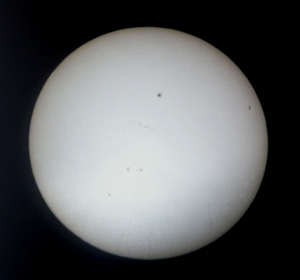Starting between 6:00 and 7:00 P.M. Friday Evening 12 April 2013 will be the Messier Marathon evening, bring your scopes and see how many Messier Objects you can record, the spring constellations will be out early to be replaced by the summer constellations later in the evening. If you do not have a Messier certificate, this will be a great opportunity to pick up some more Messier Objects for your list. Bring your scopes and have a great time hunting for Messier Objects. Call Doug Horacek for more information at 256 772-6788.
On Friday evening 22 March 2013, there will be a Youth and Adult Observing Night at 7:00 P.M. CDT, the Planetarium Presentation will begin then the topic will be Orion as the Winter Constellations begin to set in the west and make room for the Spring Constellations. Youth and Adults are invited to bring their telescopes and observe afterward. We will have view of the constellations for that evening in the Planetarium and outside the Planetarium. The Resident Astronomer Doug Horacek will give the program on Orion. Call Doug Horacek at 256 772-6788 for more information.
Saturday evening starting after program and regular observing 10 P.M. until 2:00 A.M., 11-12 August (peak evening according to Sky & Telescope, note change of date), at the VBAS field watch the Persied Meteor Shower, the Moon will be a waning crescent, estimated between 110 and 90 meteors per hour, a great evening for observing meteors given the weather holds. Come join us for a great display of the bright Persied Meteor Shower.
Target Date: Tuesday evening, 14 August, Saturn, Mars, and Spica conjunction – call Doug Horacek at 256 772-6788 will serve pizza and root beer at Doug’s Condo. Bring binoculars and scopes with a wide field of view – will start at 6:00 P.M. to set up. Event happens at dusk and a little beyond. Alternate bad viewing dates due to weather are Monday evening 13 August, or Wednesday evening 15 August.
Target Date: Tuesday evening, 21 August, Grouping of Saturn, Mars, Spica, and the Moon at the Space and Rocket Center, event occurs at dusk and a little beyond, stay posted for more details.
Early Notice: For early risers, the Beehive Cluster (M44), Venus and the Moon will be very close together in the sky at around 4:00 A.M. on the morning of 12 September, Wednesday Morning, the only morning this happens, well worth getting up to see.
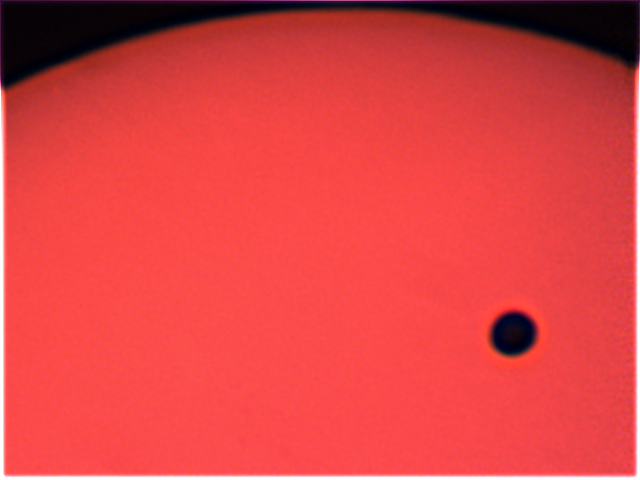
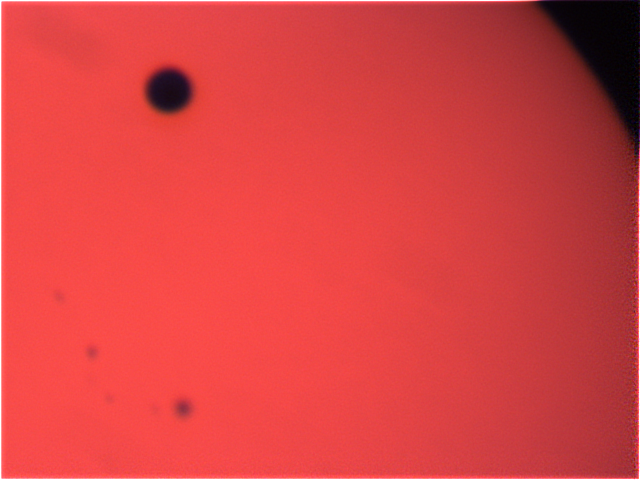
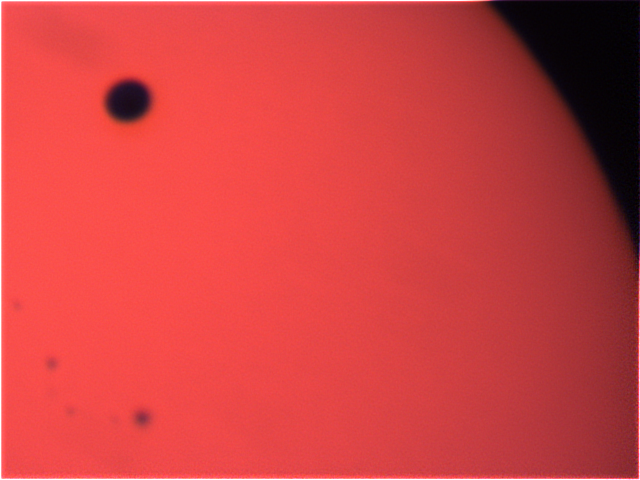
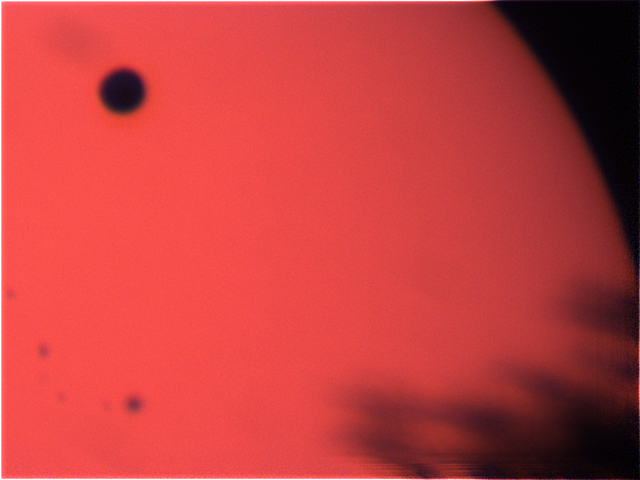
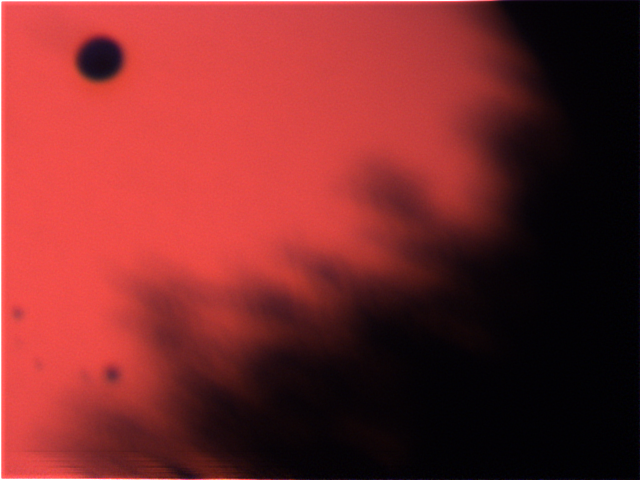 Frank Schenk captured some video of the Venus Transit betwee 19:40 and 19:45 CDT, 0:40 and 0:45 on the 6 June 2012 UT caught Venus near a Sun Spot Group Cantina 68, sunspot number is from the Cantina Obseratory in Italy, no NOAA number was referenced the next day. Frank obtained this shot with Doug Horacek’s 3.5 inch 90mm Orion Refractor, Doug moved the scope Frank took the video. These pictures were obtained just before the Sun set.
Frank Schenk captured some video of the Venus Transit betwee 19:40 and 19:45 CDT, 0:40 and 0:45 on the 6 June 2012 UT caught Venus near a Sun Spot Group Cantina 68, sunspot number is from the Cantina Obseratory in Italy, no NOAA number was referenced the next day. Frank obtained this shot with Doug Horacek’s 3.5 inch 90mm Orion Refractor, Doug moved the scope Frank took the video. These pictures were obtained just before the Sun set.
Saturday Evening 3 March 2012:
Mars Opposition
Friday and Saturday Evening 23 & 24 March 2012:
Messier Marathon #1, Saturday Evening Alternate Evening
Private Party Monday and Tuesday Evenings 2 & 3 of April 2012:
Pizza and Rootbeer at Doug’s Condo 256 772-6788 before and at Dusk
Venus in the Pleiades Cluster
Bring Scopes and Cameras, wider field of view the better
Friday Evening 13 April 2012:
Youth and Adult Observing Night Planetarium Show on Saturn begins at 7:00 P.M. for kids,
Observing afterward for kids and adults, both bring scopes.
Friday and Saturday Evenings 20 & 21 April 2012:
Messier Marathon, Saturday evening alternate evening
Friday Evening 11 May 2012:
Youth and Adult Observing Night Planetarium Show on Venus Transit begins at 7:00 P.M. for kids,
Observing afterward for kids and adults, both bring scopes.
Tuesday afternoon early evening 5 June 2012:
Set up at 3:00 or 4:00 in evening to be arranged, Transit of Venus
Possible locations:
Airfield in Decatuar with HAL5
Huntsville Botanical Garden
Burritt Museum
Friday evening 24 August 2012:
First Quarter Moon Walk with Land Trust and Sierra Club, Doug
Friday 28 September 2012 Evening:
Your and Adult Observing Night Planetarium Show on Soap Opera in the Sky for kids, Observing afterward for kids and adults bring scopes.
Morning 12 September 2012:
At 4:00 or 5:00 in morning the Beehive, M44, Venus and the Moon are less than a degree apart each in a line with the waning crescent Moon and Venus pointing to the Beehive Cluster, M44.
Best weekend for star party: 14-16 September 2012:
If you want French Camp on this date start thinking about now!
Friday Evening 5 October 2012:
Youth and Adult Observing Night Planetarium Show on Meteor showers for the Season begins at 7:00 P.M. Observing for Adults and Kids afterward.
Possible Star Party Weekend Friday thru Sunday 12-14 October 2012:
Possible star party, close to New Moon, Astronomy Day Concerns
Possible Star Party Weekend Friday thru Sunday 19-21 October 2012:
Possible Star Party, member meeting night and Astronomy Day Concerns
Possible Star Party Weekend Friday thru Sunday 9-11 November 2012:
Still Close to Last Quarter Moon, Possible Star Party
Possible Star Party Weekend Friday thru Sunday 16-18 November 2012:
Members Meeting Conflict, Close to First Quarter Moon, Weekend before Thanksgiving, Possible Star Party
On October 15, the Von Braun Astronomical Society held its annual Astronomy Day events. Huntsville Mayor Tommy Battle was on hand to kick-off the rededication of our facilities with a ribbon cutting. This year’s event was considerably larger than previous events; several estimates put the attendance around 800. We had activities starting at 1:00 PM through 10:00 PM. There was plenty to see and do for all ages, including a “moonbounce” for the young ones (or the young at heart). In addition to all the activities we had during the day, we were lucky to have some sunspots to look at this year (the sun has been pretty quiet the last few years).
Also, on hand was Ted Paludan, one of the founding members of VBAS (at the time, the Rocket City Astronomical Association) who was interviewed by Steve Doyle of the Huntsville Times. Steve’s article can be found at this link: http://blog.al.com/breaking/2011/10/von_braun_astronomical_society.html as well as many of the photographs taken by Bob Gathany.
Following all the daytime activities and planetarium shows there were throngs of people anxiously waiting to look through the 16 and 21 inch telescopes in our observatories, plus the several telescopes out on the observing field. Most of the attendees had a fantastic time looking at the universe through our telescopes. Those that hung around until Jupiter cleared the trees really had a treat to take home with them that night.Megan Beattie led the charge on this year’s very successful Astronomy Day event. She held several meetings beginning this summer and had lots of help, including Melissa Snider, Richard Norman, Gena Crook, Al Reisz, Tom Burleson, Roy Young, Doug Horcek and many more. In addition to the planning and logistics associated with such an event, we had to have the facilities cleaned up, so a major effort was undertaken to get things spruced up. There were so many folks that helped with getting the facilities ready for our grand-reopening that it would be hard to list them for fear of missing someone. Needless to say, our facilities would not look as good as they do were it not for the effort of many dedicated members and several non-members. Mimmo Demartino, Director of Facilities choreographed much of the efforts of the volunteers and has kept up with all the projects and their progress which he has listed in the facilities news section of our website at: http://www.vbas.org/index.php/facilitiesnews
Thanks go out to all the VBAS members, family and friends of members and all the friends of VBAS who helped with this year’s Astronomy Day event. It could not have been the success it was without your help and dedication. It was an…astronomical effort.
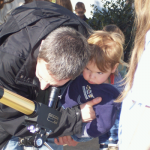
For at least three years now, the Huntsville Botanical Gardens has included VBAS Sidewalk Astronomy in their plans for their Spring and Fall campouts. We bring telescopes and star maps; they provide s’mores and a few dozen school-age children who will give us 20 minutes to wow them with a night sky wonder.
The first one arrives with a poker face: an expression that may be skeptical or shy. She may have a head full of facts (half of them newly outdated) from a brand-new astronomy book, or he may wonder how the big tube in the middle of the field could possibly be as exciting as the swift and silent owls he just saw over in the amphitheater.
What’s wonderful for a seven-year-old with a tummy full of marshmallows and chocolate?
Gadgets. It’s exciting for a child to be empowered by a new tool, and to see immediately how that tool changes his world. Extra points are added if the tool is one his parents do not already have. It’s rare that we get the opportunity to surpass our older and wiser parents, but telescopes are rare enough (even in the Rocket City) that many parents don’t have one, and perhaps even have never looked through one. Score one for the new kid in town.
Surprises. Looking into a telescope is like looking into a magic box. If you have a book about the Moon, with a picture on the cover, you have some idea what the pictures inside may look like. On the other hand, the telescope doesn’t carry a preview feature. Waiting in a short line and climbing a ladder increase the anticipation as a child forms her own mental picture of the view through the eyepiece. She spends a moment staring at a foggy black circle, shifting her eye slowly, and then: “Wowww!” Yep. She saw it. There is no faking the exclamation of wonder when she finally sees the bright rays around Tycho crater.
Connections. The bright dot in the East there, over the Sorghum Maze? That’s the thing my new friend just saw in the mysterious gadget. It looks a little like the striped planet in his book about the solar system . . . the one with all the moons. Wouldn’t it be cool to watch 65 or more moons chase each other through the sky, instead of the lonely one Moon we have? Looking through that telescope takes abstract concepts and disconnected facts, and brings them right here to Earth in Huntsville.
New skills. The regular VBAS observers know I have fallen in love with the 8″ Dob recently donated to the Society. I love it because there are 3 simple, child-friendly steps to using it: 1) look at the Moon, 2) grab the tube and point it where you’re looking, and 3) look to see if you pointed correctly. The reward is a breathtaking view no one else can see until it is their turn to try those three steps. In five minutes, a child as young as four or five knows how to do something cool! In the midst of music lessons (a month to learn a short, slow song), first bicycle rides (untold numbers of wobbly starts before the first successful sprint), and school tests (in which succeeding means moving on to another round of unfamiliar words or numbers), this simple success offers an encouraging platform for a lifelong hobby. Better still, success can still be found on a cloudy night: there are at least two radio towers visible from the Gardens’ campout site which make great targets for new telescope users.
In the past three years, at least a half dozen VBAS observers have re-discovered the things that hooked us into astronomy in the first place. Megan, James and Melissa had a great session on September 16. John Young is heading the October 7 session, and Society scopes are available for checkout. Can you have more fun than we did? We double-dog-dare you to try!
